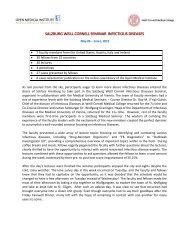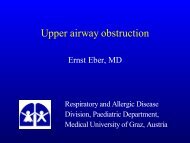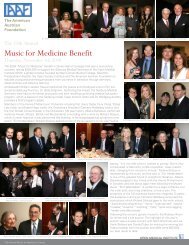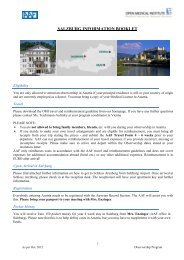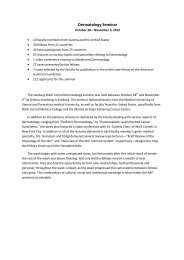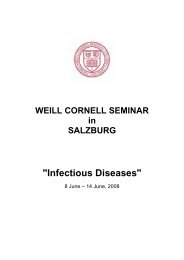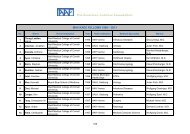Diagnosis and management of early- and late-onset cerebellar ataxia
Diagnosis and management of early- and late-onset cerebellar ataxia
Diagnosis and management of early- and late-onset cerebellar ataxia
Create successful ePaper yourself
Turn your PDF publications into a flip-book with our unique Google optimized e-Paper software.
9. Paraneoplastic antibodies:<br />
Antibody<br />
Coexisting<br />
symptoms (apart<br />
from <strong>ataxia</strong>) Associated cancers<br />
Anti-Yo — Gynaecological,<br />
breast<br />
Anti-Tr — Hodgkin lymphoma<br />
Anti-mGluR1-a — Hodgkin lymphoma<br />
Anti-Zic4 — Small cell lung<br />
Anti-Hu Encephalomyelitis,<br />
limbic encephalitis,<br />
sensory neuronopathy,<br />
autonomic<br />
dysfunction<br />
Anti-Ri Opsoclonus-myoclonus,<br />
brain stem<br />
encephalitis<br />
Anti-Ma Limbic <strong>and</strong> brain<br />
stem encephalitis,<br />
Opsoclonus-myoclonus<br />
carcinoma (SCLC)<br />
SCLC, neuroblastoma,<br />
sarcoma,<br />
other<br />
Breast, gynaecological,<br />
SCLC<br />
Breast<br />
Anti-PCA2 Encephalomyelitis SCLC<br />
Anti-CRMP Encephalomyelitis,<br />
chorea, polyneur-<br />
opathy<br />
Anti-VGCC Autonomic dysfunction,<br />
Lambert<br />
Eaton myastenic<br />
syndrome<br />
SCLC, thymoma,<br />
germ cell tumours<br />
<strong>of</strong> testis<br />
SCLC<br />
Lumbar puncture in screening for inflammatory/immune-mediated<br />
disorders:<br />
Study Indicative <strong>of</strong><br />
Mononuclear <strong>and</strong> polynu- infections, immuneclear<br />
lymphocytes, glucose mediated disorders<br />
Protein, IgG index (immune inflammation, immune-<br />
electrophoresis)<br />
mediated disorders,<br />
demyelinization<br />
Consider: lactate, pyruvate mitochondrial disorders<br />
Consider: viral/infectious infection by borrelia, crypto-<br />
screening<br />
coccus, herpes, Epstein-<br />
Barr virus (EBV),<br />
Coxsackie, echo, human<br />
immunodeficiency virus<br />
(HIV), human T-cell lymphotropic<br />
virus (HTLV1), or<br />
toxoplasmosis, leptospirosis,<br />
tuberculosis<br />
10. Laboratory studies for whipple <strong>and</strong> malabsorption:<br />
Study Indicative <strong>of</strong><br />
Vitamin E, B1, B6, B12,<br />
cholesterol triglycerides,<br />
low-density lipoprotein, very<br />
low-density lipoprotein<br />
malabsorption, vitamin<br />
deficiency<br />
PCR Tropheryma whippelii whipple disease<br />
<strong>Diagnosis</strong> <strong>and</strong> <strong>management</strong> <strong>of</strong> <strong>cerebellar</strong> <strong>ataxia</strong><br />
References<br />
1. Holmes G. An attempt to classify <strong>cerebellar</strong> disease, with<br />
a note on Marie’s hereditary <strong>cerebellar</strong> <strong>ataxia</strong>. Brain 1907:<br />
30: 545–567.<br />
2. Harding AE. Clinical features <strong>and</strong> classification <strong>of</strong> inherited<br />
<strong>ataxia</strong>s. Adv Neurol 1993: 61: 1–14.<br />
3. Harding AE. Classification <strong>of</strong> the hereditary <strong>ataxia</strong>s <strong>and</strong><br />
paraplegias. Lancet 1983: 21: 1151–1155.<br />
4. Harding AE. ‘‘Idiopathic’’ <strong>late</strong> <strong>onset</strong> <strong>cerebellar</strong> <strong>ataxia</strong>. A<br />
clinical <strong>and</strong> genetic study <strong>of</strong> 36 cases. J Neurol Sci 1981: 51:<br />
259–271.<br />
5. Kerber KA, Jen JC, Perlman S et al. Late-<strong>onset</strong> pure<br />
<strong>cerebellar</strong> <strong>ataxia</strong>: differentiating those with <strong>and</strong> without<br />
identifiable mutations. J Neurol Sci 2005: 238: 41–45.<br />
6. Abele M, Bu¨ rk K, Scho¨ ls L et al. The aetiology <strong>of</strong> sporadic<br />
adult-<strong>onset</strong> <strong>ataxia</strong>. Brain 2002: 125: 961–968.<br />
7. Scho¨ ls L, Szymanski S, Peters S et al. Genetic background<br />
<strong>of</strong> apparently idiopathic sporadic <strong>cerebellar</strong> <strong>ataxia</strong>. Hum<br />
Genet 2000: 107: 132–137.<br />
8. Finsterer J. Mitochondriopathies. Eur J Neurol 2004: 11:<br />
163–186.<br />
9. Scho¨ ls L, Bauer P, Schmidt T et al. Autosomal dominant<br />
<strong>cerebellar</strong> <strong>ataxia</strong>s: clinical features, genetics <strong>and</strong> pathogenesis.<br />
Lancet Neurol 2004: 3: 291–304.<br />
10. Perlman SL. Autosomal dominant <strong>ataxia</strong>s. In: Lynch DR,<br />
ed. Neurogenetics, scientific <strong>and</strong> clinical advances, 1st<br />
edn. Taylor <strong>and</strong> Francis Group, New York, 2006:<br />
311–355.<br />
11. Bird TD. Hereditary <strong>ataxia</strong> overview. http://www.gene<br />
clinics.org/servlet/access?db=geneclinics&site=gt&id=<br />
8888891&key=Fkx-A35oEHZ2G&gry=&fcn=y&fw=g8bn<br />
&filename=/pr<strong>of</strong>iles/<strong>ataxia</strong>s/index.html (accessed 30<br />
March 2006).<br />
12. Pestronk A. http://www.neuro.wustl.edu/neuromuscular/<br />
<strong>ataxia</strong>/aindex.html (accessed 30 March 2006).<br />
13. Spacey S. Episodic <strong>ataxia</strong> type 2. http://www.geneclinics.org/<br />
servlet/access?db=geneclinics&site=gt&id=8888891&key=<br />
06iI-vAoT3w2W&gry=&fcn=y&fw=XK5l&filename=/<br />
pr<strong>of</strong>iles/ea2/index.html (accessed 9 April 2006).<br />
14. Jen JC, Wan J, Palos TP et al. Mutation in the glutamate<br />
transporter EAAT1 causes episodic <strong>ataxia</strong>, hemiplegia <strong>and</strong><br />
seizures. Neurology 2005: 65: 529–534.<br />
15. Baloh RW, Jen JC. Genetics <strong>of</strong> familial episodic vertigo<br />
<strong>and</strong> <strong>ataxia</strong>. Ann NY Acad Sci 2002: 956: 338–345.<br />
16. Van de Warrenburg BP, Sinke RJ, Verschuuren-Bemelmans<br />
CC et al. Spino<strong>cerebellar</strong> <strong>ataxia</strong>s in the Netherl<strong>and</strong>s:<br />
prevalence <strong>and</strong> age at <strong>onset</strong> variance analysis. Neurology<br />
2002: 58: 702–708.<br />
17. Van Swieten JC, Brusse E, De Graaf B et al. A mutation in<br />
the fibroblast growth factor 14 gene is associated with<br />
autosomal dominant <strong>cerebellar</strong> <strong>ataxia</strong> (corrected). Am J<br />
Hum Genet 2003: 72: 191–199.<br />
18. Lin X, Ashizawa T. Recent progress in spino<strong>cerebellar</strong><br />
<strong>ataxia</strong> type-10 (SCA10). Cerebellum 2005: 4: 37–42.<br />
19. Ishiwaka K, Toru S, Tsunemi T et al. An autosomal<br />
dominant <strong>cerebellar</strong> <strong>ataxia</strong> linked to chromosome<br />
16q22.1 is associated with a single-nucleotide substitution<br />
in the 5# untrans<strong>late</strong>d region <strong>of</strong> the gene encoding a<br />
protein with spectrin repeat <strong>and</strong> rho guanine-nucleotide<br />
exchange-factor domains. Am J Hum Genet 2005: 77:<br />
280–296.<br />
20. Ikeda Y, Dick KA, Weatherspoon MR et al. Spectrin<br />
mutations cause spino<strong>cerebellar</strong> <strong>ataxia</strong> type 5. Nat Genet<br />
2006: 38: 184–190.<br />
21. Dalski A, Atici J, Kreuz FR et al. Mutation analysis in the<br />
fibroblast growth factor 14 gene: frameshift mutation <strong>and</strong><br />
23



